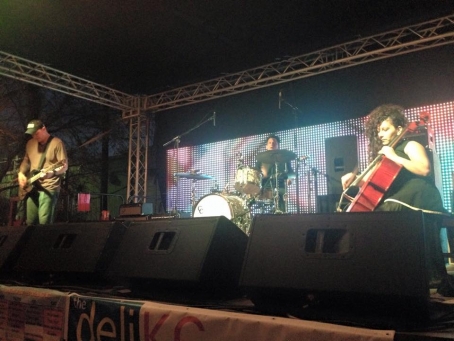The Medicine Theory is an experimental rock music trio comprised of baritone guitarist Jeff Irvine, percussionist/vocalist Tyson Schroeder, and cellist Barbara Anndrea Arriaga-Delaney. The two-piece version, drums and guitar—formed in 2007—played a set at Harling’s Upstairs a couple weeks ago and chatted with me afterward.
Schroeder and Irvine met in various performing and visual arts classes during high school and soon began playing in punk/metal bands. A few years later, the two were playing in KC speed metal/punk band Methods of Man (1994-1997). After a few years, Schroeder decided to take a break from music. Soon after, Irvine moved to Philadelphia then Washington DC to pursue his degree. By 2000, Schroeder moved to Cape Cod to focus on painting while working and living at the newly opened museum estate of artist and author Edward Gorey.
“At that time,” said Schroeder, “I was done playing in bands. I was going to play, but only if I was having fun with it like I did when I was 18.” Then he visited Irvine in DC and fun ensued. “It was pretty much, let’s drink absinthe and make noises and record them,” said Schroeder. Irvine recalls, “We did that… quietly,” with his girlfriend, now wife, asleep in the next room.
The two had fun, stayed up all night and a few months later met again in Cape Cod. They set up a mini recording studio in one of the estates, Barns (no absinthe this time, just volume), and set about recording “everything we could,” said Irvine. “It was pretty much the beginning of this band,” recalls Schroeder. And it became the template for how the two would write music.
“We wanted to write like we did when we first started,” said Schroeder, “when we didn’t know what the fuck we were doing… anything goes.” After so many years playing off of each other, Irvine mentioned, “There’s a lot of instinct. Things just happen.” In late 2014 the two-piece became a trio thanks to cellist Arriaga-Delaney.
Schroeder’s percussion is deliberate and big. At times his style and sound somehow lean towards jazz-punk, all the while maintaining an unwavering weight and drive. His vocals expand and retract from the hushed tones of a madman mid-conversation to a shouting lunatic, depending on the story he’s telling or the character being brought to life. Schroeder and Irvine are both visual artists as well as musicians, and this lends nicely to the characters and stories created in their songwriting. Barreling through, over and around all of this is Irvine’s sonic-laced baritone. At times jagged and driving, at others melodic, almost adrift, it is evident he knows how to simply let a song—a story, unfold. Irvine played bass for a long time before picking up guitar and this can be heard in the reserve with which he attacks songs, holding down steady rhythms and flourishes as well as succinct leads.
The advent of Austin-based cellist Arriaga-Delaney started as an experiment on a few songs in 2014. By March 2015 the band had played a few shows together and were set to play the MidCoast Takeover stage at SXSW. “She wanted to just do 2 or 3 songs, like she’d done previously,” says Irvine. Schroeder notes, “But we both really liked what she was bringing to the table.” Irvine let Arriaga-Delaney in on a secret. “We’re going to do a full set with you.” The cellist agreed. “She showed to us that she really wanted to be a part of this.”
There were a few obstacles, though. Less than a week before the showcase, she had injured her hand and didn’t know the whole set list. But she toughed it out. “Six days in a row,” says Irvine. Schroeder recalls 4- to 6-hour rehearsals.
Arriaga-Delaney is a busy cellist. She played in a band calle And The Furies Say, as well as Reverend Glasseye, a Boston-based band that transplanted to Austin, where she got hooked up with them.” According to Schroeder, “She tours around a lot playing solo things, playing with other people. She’s definitely a free spirit—a gypsy lady.” Recently, she worked on a score for a film in real time. “She was out in the desert with them while they were filming it, just coming up with a soundtrack. They put her in the film but they were also recording her live.”
The effect of Arriaga-Delaney’s cello on The Medicine Theory’s sound is as subtle yet decisive. The arrangements haven’t changed but have grown. The mood and tone of songs has shifted. The modicum of levity in Schroeder’s vocal attack has decreased with the infusion of the cello, while the stark melancholy has increased. “Covered Bridge” shifts from dark yet driven to stoic, moody, and downright estranged. The song “Timmy,” a twisted fun house take on a very dark subject matter, maintains a sense of levity. But as Irvine and Schroeder romp through the song, Arriaga-Delaney casually creates a sense of foreboding that wasn’t there before. Like smoke slowly filling a room.
Putting a finger on the sound this trio is creating is maddening, impossible, and unnecessary. Comparisons to other groups don’t quite fit. The sound is uniquely their own, and that is the intention.
–Chris Nielsen

The Medicine Theory plays at The Riot Room on Sunday, April 26, with Ides of Gemini, Sedlec Ossuary, and The Last Glacier. Facebook event page.
